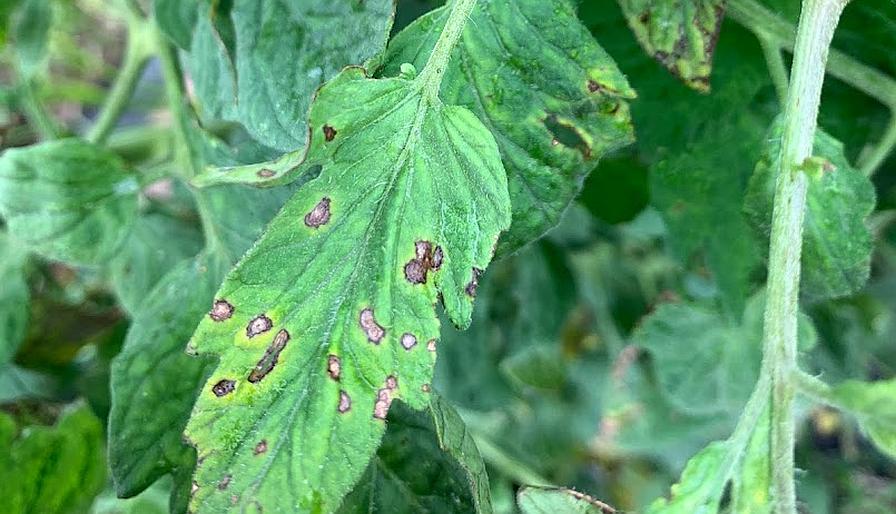A New Bacterial Spot Strain Is a Headache for Tomato Growers

Symptoms of bacterial spot on tomato.
Photo by Zachary Snipes
Bacterial spot ranked No. 3 in the diseases most impacting growers responding to the American Vegetable Grower 2023 State of the Vegetable Industry survey.
Here in South Carolina, I certainly have seen my share of fall tomato plants partially defoliated by bacterial spot, even though they were blue with copper residue.
New Kid on the Block
As the disease name says, bacterial spot is caused by a bacterium. In this case, one of four related bacteria with the “surname” Xanthomonas. X. euvesicatoria used to be the most common cause of bacterial spot. The newest bacterium, X. perforans (Xp for short), was found for the first time in Florida in 1991. Since then, Xp has spread throughout not only Florida but the southeastern tomato-producing regions, as far north as the mountains of North Carolina and as far west as Louisiana. In a 2017 survey in Florida and South Georgia, Xp, and only Xp, was found in all 70 fields sampled. Why?
New research from the University of Florida, led by my colleagues Gary Vallad in Wimauma and Jeff Jones in Gainesville, found that Xp out-competes other bacteria on plant surfaces. First, Xp makes toxins that kill X. euvesicatoria, its closest competitor for space on susceptible tomato leaves.
Xp also produces volatile organic compounds that stop the growth of several other bacteria, including the one that causes tomato canker. Clearly Xp is not only an aggressive pathogen on tomato, but it also bullies other bacteria.
Control But No Yield Boost
As expected, 99.8% of the Xp strains collected in the 2017 survey were copper tolerant. This tolerance is why the standard spray recommendation was copper plus a low rate of mancozeb, which enhances the effectiveness of copper against copper-tolerant bacteria.
This pesticide program, however, has outlived its usefulness, at least in the Southeast.
It reduced symptoms of bacterial spot on tomato leaves in only one of seven field trials done between 2018 and 2020. Interestingly, in the Midwest, the same program worked in four of four trials against Xp. It’s very possible the warm, humid growing environment in the Southeast makes control more difficult here.
Growers sell tomato fruit, not leaves, so the real test of a spray program is marketable yield. Fortunately, Xp does not infect fruit as often as X. euvesicatoria used to. This may be one reason spraying copper plus mancozeb against Xp doesn’t help.
Marketable weight was greater than the non-sprayed control in only one of 10 trials, which was done in Indiana with copper-sensitive Xp.
In the other nine trials, yields in the non-sprayed and sprayed plots were statistically similar. This result, from different trials and locations, means growers and pathologists may be over-emphasizing spraying for bacterial spot, particularly when the cost of sprays, fuel, and labor is measured, as trials in Florida did (see https://is.gd/spotty_tomatoes).
Other Issues to Consider
In a few trials, the cure was almost as bad as the disease. Yields tended to be lower in some treated plots than in the non-sprayed plots. Note that these issues were seen in single trials. So I mention them only as a caution, not a recommendation to avoid certain products.
In a local on-farm trial in South Carolina, tomato cultivar BHN 669 treated weekly with Leap (Valent BioSciences) alternated with Mankocide (Certis Biologicals) yielded the best based on four harvests. Compared to Leap-Mankocide, bacterial spot reduced yields in the nontreated plots by 15%, but Actigard (Syngenta) alternated with Mankocide reduced yields by 17%.
In North Carolina, ‘Mountain Gem’ tomatoes (Bejo Seeds) sprayed with Nordox 75 (Brandt) or Nordox 30/30 had 12% lower yields than nonsprayed plants, while the grower standard of Kocide (Certis Biologicals) plus Manzate (United Phosphorus) alternated with Actigard plus Manzate had 3% lower yields.
Give Staked Tomatoes More Breathing Room
To close on a positive note, the best-looking field of fall tomatoes I’ve seen was on an organic farm. The weekly sprays of copper plus a Bacillus biopesticide helped, as older research at the University of Florida showed this program reduced symptoms. (Yields were not measured in that study.)
What also helped was the 12-foot row spacing. More research in Florida recently found that Xp cells can aerosolize in a greenhouse and spread six feet. If the same thing happens during rain, wide row spacing would reduce spread.










